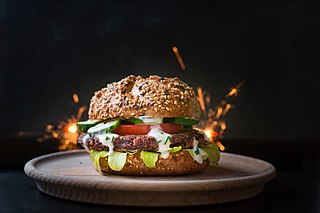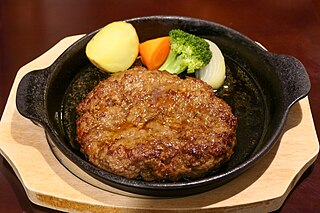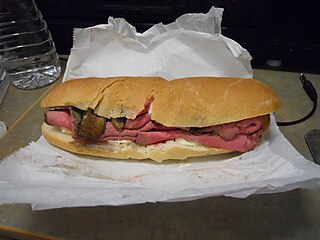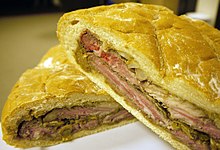
A hamburger, also called a burger, is a dish consisting of fillings—usually a patty of ground meat, typically beef—placed inside a sliced bun or bread roll. The patties are often served with cheese, lettuce, tomato, onion, pickles, bacon or chilis with condiments such as ketchup, mustard, mayonnaise, relish or a "special sauce", often a variation of Thousand Island dressing and are frequently placed on sesame seed buns. A hamburger patty topped with cheese is called a cheeseburger.

A sandwich is a dish typically consisting of vegetables, sliced cheese or meat, placed on or between slices of bread, or more generally any dish wherein bread serves as a container or wrapper for another food type. The sandwich began as a portable, convenient finger food in the Western world, though over time it has become prevalent worldwide.

Belgian cuisine is widely varied among regions, while also reflecting the cuisines of neighbouring France, Germany and the Netherlands. It is sometimes said that Belgian food is served in the quantity of German cuisine but with the quality of French food. Outside the country, Belgium is best known for its chocolate, waffles, fries and beer.

A cheesesteak is a sandwich made from thinly sliced pieces of beefsteak and melted cheese in a long hoagie roll. A popular regional fast food, it has its roots in the U.S. city of Philadelphia, Pennsylvania.

Meatloaf is a dish of ground meat that has been combined with other ingredients and formed into the shape of a loaf, then baked or smoked. The final shape is either hand-formed on a baking tray, or pan-formed by cooking it in a loaf pan. It is usually made with ground beef, although ground lamb, pork, veal, venison, poultry, and seafood are also used, sometimes in combination. Vegetarian adaptations of meatloaf may use imitation meat or pulses.

Chateaubriand is a dish that traditionally consists of a large front cut fillet of tenderloin grilled between two lesser pieces of meat that are discarded after cooking. While the term originally referred to the preparation of the dish, Auguste Escoffier named the specific front cut of the tenderloin the Chateaubriand.

Steak tartare or tartar steak is a French dish of raw ground (minced) beef. It is usually served with onions, capers, parsley or chive, salt, pepper, Worcestershire sauce, and other seasonings, often presented separately, to be added to taste. It is always served topped with a raw egg yolk. It is similar to the Levantine kibbeh nayyeh, the Turkish çiğ köfte and the Korean yukhoe.

A schnitzel is a thin slice of meat. The meat is usually thinned by pounding with a meat tenderizer. Most commonly, the meat is breaded before frying. Breaded schnitzel is popular in many countries and is made using veal, pork, chicken, mutton, beef, or turkey. Schnitzel originated as wiener schnitzel and is very similar to other breaded meat dishes.

Beef Wellington is a steak dish of English origin, made out of fillet steak coated with pâté and duxelles, wrapped in puff pastry, then baked. Some recipes include wrapping the coated meat in a crêpe or dry-cured ham to retain the moisture and prevent it from making the pastry soggy.

A garnish is an item or substance used as a decoration or embellishment accompanying a prepared food dish or drink. In many cases, it may give added or contrasting flavor. Some garnishes are selected mainly to augment the visual impact of the plate, while others are selected specifically for the flavor they may impart. This is in contrast to a condiment, a prepared sauce added to another food item primarily for its flavor. A food item which is served with garnish may be described as being garni, the French term for "garnished."

Hamburg steak is a patty of ground beef. Made popular worldwide by migrating Germans, it became a mainstream dish around the start of the 19th century. It is related to Salisbury steaks, which also use ground beef. It is considered the origin of the hamburger, when, in the early 20th century, vendors began selling the Hamburg steak as a sandwich between bread.

A steak sandwich is a sandwich prepared with steak that has been broiled, fried, grilled, barbecued or seared using steel grates or gridirons, then served on bread or a roll. Steak sandwiches are sometimes served with toppings of cheese, onions, mushrooms, peppers, tomatoes, and in some instances fried eggs, coleslaw, and french fries.

The roast beef sandwich is a sandwich that is made out of sliced roast beef or sometimes beef loaf. It is sold at many diners in the United States, as well as fast food chains, such as Arby's, Rax Roast Beef, and Roy Rogers Restaurants. This style of sandwich often comes on a hamburger bun and may be topped with barbecue sauce and/or melted American cheese. The roast beef sandwich also commonly comprises bread, cold roast beef, lettuce, tomatoes, and mustard, although it would not be uncommon to find cheese, horseradish, fresh/powdered chili pepper and even in some cases red onion. Roast beef sandwiches may be served hot or cold, and are sometimes served open faced.

Crab dip, sometimes referred to as Maryland crab dip, is a thick, creamy dip that is typically prepared from cream cheese and lump crab meat. Other primary ingredients such as mayonnaise may be used. Various types of crab preparations, species and superfamilies are used, as are a variety of added ingredients. It is typically served hot, although cold versions also exist. Hot versions are typically baked or broiled. It is sometimes served as an appetizer. Accompaniments may include crackers and various breads. Some U.S. restaurants offer crab dip, commercially produced varieties exist, and some stadiums offer it as a part of their concessions.

Sautéed mushrooms is a dish prepared by sautéing edible mushrooms. It is served as a side dish, used as an ingredient in dishes such as coq au vin, beef bourguignon, and foods such as duxelles, as a topping for steaks and toast, and also as a garnish.

Indo cuisine is a fusion cooking and cuisine tradition, mainly existing in Indonesia and the Netherlands, as well as Belgium, South Africa and Suriname. This cuisine characterized of fusion cuisine that consists of original Indonesian cuisine with Eurasian-influences—mainly Dutch, also Portuguese, Spanish, French and British—and vice versa. Nowaday, not only Indo people consume Indo cuisine, but also Indonesians and Dutch people.

















